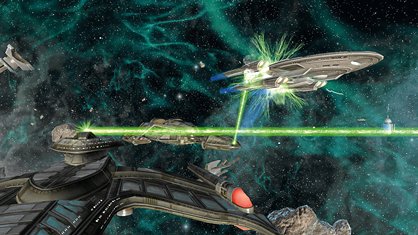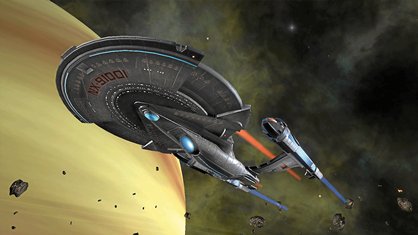Star Trek Online – hands-on
A daringly unusual idea for an MMORPG, but what's it actually like to play?
You have two weapons, while each of your crew has one. We started with a phaser and phase rifle – both have similar basic attacks, but the phaser’s secondary stuns (of course) and the rifle’s secondary fires a split beam to hit two targets at once. Aside from that and a melee bash, all you’ve got are a few skills and any medkits or grenades you’ve accumulated. So your options are kept fairly simple at first, which frees you to get the hang of managing your subordinates.

The extent of our tactics was ordering our crew to all fire on our target, and when that didn’t work, ordering them all to stay where they were so we could run away – your ‘personal shield’ regenerates over time. But there’s the potential for tactical thought here; it just isn’t relevant at such low levels.
You do gain new skills as you’re promoted through the Starfleet ranks, but the more dramatic changes to your abilities happen when you find new kits. We mentioned nine classes, but you only commit to one of three broad career paths – Tactical, Engineering or Science – and further specialisation comes mainly from the abilities kits grant you.
One extreme example, which Cryptic say might change, was a Combat Engineer kit with so many different grenade types that you could be lobbing explosives continuously, without ever having to wait for their individual cooldown times to expire. Other kits let Engineers deploy turrets, shields and healing stations, or allowScientists to revive crewmates and undermine enemy weapons, or give Tactical Officers the ability to sneak and even use new close combat moves. The one we were using confusingly granted us a Leg Sweep – perhaps by replacing the restrictive standard Starfleet trousers with tactical pantaloons.

The upshot is that your role can change with a good bit of loot: most of the best kits are rewards for story missions, and helping out a tech-savvy race usually means getting a great Engineering kit as part of your reward. If you’ve messed around with class mods in Borderlands, it’s a more extreme version of that system.
At a more advanced level, some skills and tools make use of STO’s Expose, Extend and Exploit combat system. Attacks that Expose leave the enemy vulnerable, and the next hit they take will do more damage. Attacks that Exploit are more damaging still to an Exposed enemy. And Extend skills, used on an already Exposed enemy, set him up for an Exploit powerful enough to kill a standard enemy instantly.
It’s all a little too beat-‘em-up for a Star Trek game, and these words don’t relate to what’s really going on: you’re all exposed, standing in a corridor or in the open on a planet without much of a cover system. But from a detached gamer’s perspective, this is quite a satisfying and teamplay focused approach. Our bigger concern is that there was just too much combat in the missions we played: that’s just not Star Trek. We were itching to get back into space.
Weekly digests, tales from the communities you love, and more

We decided to arbitrarily switch the ship’s photon torpedo launcher with its rear phaser bank, crippling our ability to torpedo enemy hulls once their shields are down. In space, you have an overwhelming amount of flexibility in how you fit, configure and crew your ship. There are masses of different modules to fit it with, many ways to fit any given set of them, and many ways to use any given fitting. At its most basic, you close in on enemy ships fairly slowly, pelt one side of their shields with phaser fire until they go down, then try to stay on their weak side long enough to launch torpedoes that’ll rip through their hull.


